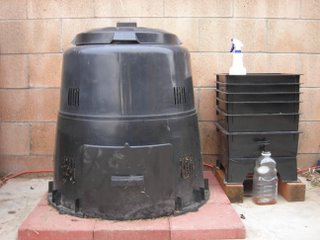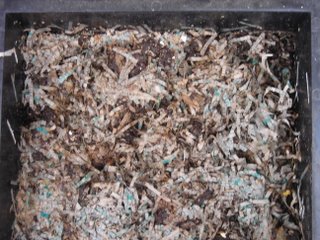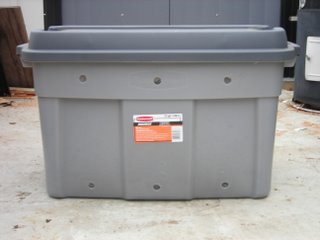Got Compost?
Just so you know, in case we ever meet, I've got bad case of worms!
About six months ago I purchased a Worm Factory (see here) vermiculture composter and started using redworms to compost my kitchen scraps. It took a little while before the worms started to eat and reproduce, but once they did .. watch out. Those little suckers are pigs, they eat like crazy and are prolific breeders.
Of course it's environmentally friendly to limit the amount of garbage that ends up in the landfill, even if it's only kitchen scraps; but that isn't why I'm composting using worms, the real reason is .... their poop. Worm poo, or "castings" are relished as a natural fertilizer. There's some debate as to whether or not the worm poo is "organic". Some of the greener folks feel that the castings aren't organic unless the food that the worms eat is also organic. As for me ..... w-h-a-t-e-v-e-r.
My Worm Factory is a 5 tray system. The trays stack on top of each other. As one tray becomes full of worm poo, I begin adding food to the tray above it. Then as that tray fills up with poo, I start adding food to the next tray. The trays have small holes in the bottom which allow the worms to migrate up into the tray(s) with food. When the 5th tray becomes full you empty all the worm poo out of the 1st tray, rotate it to the top and start filling it with food. The tray that you are putting food in is called the working tray. The sequence can continue forever. A healthy Worm Factory can produce a tray of worm poo fertilizer a month.
Redworms will eat anything organic. Kitchen scraps (but not meat products or cheese) are the most common food for redworms; but they will also eat paper, natural fibers, cardboard, leaves, grass clippings (you have to be careful with green grass because it can heat up when decomposing and bake the worms. If that happens you will end up with worm/poo pie). Redworms are especially fond of coffee grounds.
Now, worms are not all that different then you and I. When they eat they not only poo ... they pee. The base of the Worm Factory is a reservoir that collects the worm wee. It has a spigot type of drain that allows you to collect the wee. Worm wee is also a great fertilizer. I have a plastic juice bottle under the drain, I just leave it open so it is always draining. When the bottle gets about 1/2 full I'll dilute the worm wee with an equal amount of water and use it as fertilizer in the garden.
The Worm Factory is on the right. On the left is an Earth Machine backyard composter. I use the Earth Machine to compost grass clippings and leaves. I have also recently secured a source of chicken poo and goat poo to add to the compost bin. Animal poo is excellent to compost as long as the animal is not a meat eater (no dog, cat or human poo in the compost bin!!). I'm looking for a source of rabbit poo .. that would be some great sh!t.

The working tray of my Worm Factory. This tray is full. I need to begin adding food to the tray above. The worms will eat the remainder of the shredded newspaper on their way up into the next bin.

I mentioned in my first post that last year I built my first elevated planter. I hadn't yet heard of Square Foot Gardening, so that planter was deeper (6' X 2' X 15") and filled with general use potting soil. To improve the soil condition I purchased a cup of earthworms at OSH (abt. 200 worms @ $10) and put them in the planter (Note: earthworms and composting redworms are completely different, they are not interchangeable). This year, in February, I tilled all the soil in that planter to get it ready for planting (still hadn't heard of SFG yet). I was pleasantly surprised at the amount of earthworms in the planter. They had obviously multiplied and ate from the organic material in the potting soil; they were large and active. I mixed a bunch of leaves into the soil to give the worms plenty to eat and then planted a few vegetable plants into that bed. I decided that I want to add earthworms into all my planters and pots in which I use regular potting soil.
Now, I'm cheap, and I didn't want to continue to purchase earthworms. What I did instead was make a worm habitat so I can breed my own earthworms. I used a 37 gal. Rubbermaid plastic storage container and drilled several 1" holes for air circulation and glued aluminum window screen to the holes to keep pests out and the worms in. I installed a drain by drilling a 1" hole on the side near the bottom. I cut the top off of a water bottle and glued it into the hole (totally water tight). In order to keep the soil elevated above the drain I constructed a crude elevated floor in the container using landscaping stakes and more aluminum window screen. I filled the container with left over potting soil and leaves, wet it down thoroughly with the hose and added the last container of earthworms that I intend to ever buy. I'm hoping that by planting season next year the worm habitat will have thousands of worms that I can use for my planters and beds, and for continued breeding.

Inside the earthworm habitat.
